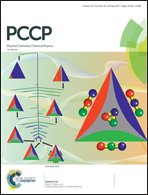Self-assembly of inverse patchy colloids with tunable patch coverage†
Abstract
We report a simple and scalable technique for the preparation of patchy particles with tunable patch coverage. These particles are categorized as inverse patchy colloidal particles (IPCs) as the patches repel each other while patch and non-patch surfaces attract. We demonstrate the effect of patch coverage, concentration of electrolyte and concentration of particles on the self-assembly of IPC particles. The study identifies various clustering zones such as (1) finite-sized clusters, (2) chain-like assemblies and (3) irregular amorphous aggregates. The linear assemblies are observed over a wide range of particle concentrations and salt concentrations. The anisotropic electrostatic interaction controls the formation of chain-like assemblies. In an extended study, we use negatively charged isotropic colloidal (NCIC) particles to tune the self-assembly of IPC particles. Interestingly, we observe significant improvement in the clustering efficiency of IPC particles leading to the formation of co-polymeric, flexible branched chains. Depending on the number ratio of NCIC particles with respect to IPC particles, the clustering process is classified into three different phases such as (1) finite-sized, (2) linear and (3) dispersed state. Using a quantitative analysis we show that such evolution of structures is attributed to seeding and crowding effects caused by the addition of NCIC particles. The use of NCIC particles thus control the self-assembly of inverse patchy colloids and tune the number and shape of the self-assembled structures.



 Please wait while we load your content...
Please wait while we load your content...